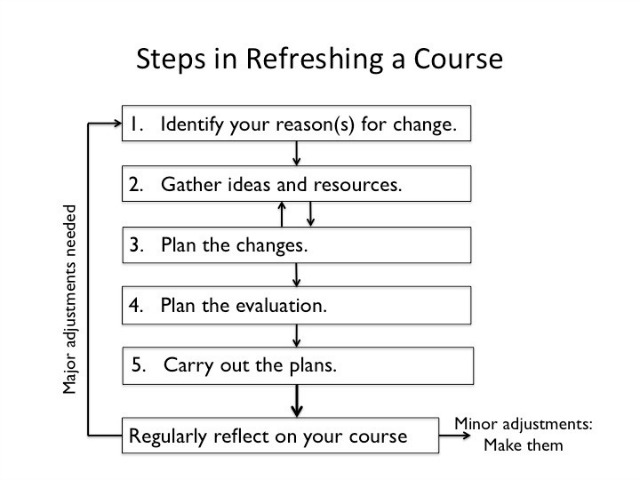Instructors commonly cope with a missed test or failed exam (this may also apply to quizzes) by letting students drop their lowest score. Sometimes the lowest score is replaced by an extra exam or quiz. Sometimes the tests are worth different amounts, with the first test worth less, the second worth a bit more, and the third worth more than the first two—but not as much as the final.
Read more ›CURRENT ARTICLE • October 20
OTHER RECENT ARTICLES
I looked down into the menacing waters as a rogue wave jolted the raft. Trembling, I stepped back, my chattering teeth and throbbing heart in perfect sync.
Read More ›Trying to support students in an online course can create an unsustainable burden on the instructor. “I’ve heard faculty members say things such as, ‘When I first started teaching online, I drowned in my course. I was making myself available 24 hours/seven days a week. If a student posted, I felt I had to reply immediately. They were counting on me regardless of time of day,’” says Dr. Laurie Grosik, assistant professor in the master in health science program at Saint Francis University. In an interview with Online Classroom, she suggested ways to support online students without creating an undue burden on the instructor.
Read More ›As faculty, it seems we are very concerned about cell phones in the classroom. Articles about the problem are popping up everywhere in the pedagogical literature, and they often are the “most-read” and “most-commented” articles listed on various websites. Is student use of electronic devices that pressing of a pedagogical problem? I’ve been wondering if our focus on it isn’t becoming excessive.
Read More ›Goals for my First-Year Seminar students include proficiency with a host of study skills as well as course content based on what we call “learning about learning.” To support new college students in understanding what, exactly, learning is, my colleagues and I introduce a number of themes and authors to our students over the course of the first semester. Themes can include locus of control, memory learning and the brain (including information processing models), current research on learning disabilities, theories of motivation and learning, mind-set theory, emotional intelligence theories, and research on millennial students just like them. Students read materials written by authors doing work in these areas.
Read More › With access to a world of information as close as our phones, it’s easy to feel overwhelmed by all there is to teach. New material continues to emerge in every academic discipline, and teachers feel a tremendous responsibility not only to stay current themselves, but to ensure that their learners are up to date on the most recent findings. Add to this information explosion the passionate desire by faculty members to share their particular areas of expertise and it’s easy to see why content continues to grow like the mythical Hydra of Greek legend. And like Hercules, who with each effort to cut off one of Hydra’s nine heads only to have two more grow in its place, faculty struggle to tame their content monsters.
With access to a world of information as close as our phones, it’s easy to feel overwhelmed by all there is to teach. New material continues to emerge in every academic discipline, and teachers feel a tremendous responsibility not only to stay current themselves, but to ensure that their learners are up to date on the most recent findings. Add to this information explosion the passionate desire by faculty members to share their particular areas of expertise and it’s easy to see why content continues to grow like the mythical Hydra of Greek legend. And like Hercules, who with each effort to cut off one of Hydra’s nine heads only to have two more grow in its place, faculty struggle to tame their content monsters.
 Haven’t we all entertained that inquiry from an absent student, “Did I miss anything important?” The question is poorly phrased, but I recognize that it’s usually well-intentioned. The student is concerned about what he or she missed. My concern is about those continued absences and how to allow the student to make up for a missed class. The first day of class I read a Tom Wayman poem (www.loc.gov/poetry/180/013.html) that gets at the phrasing of the question and what the student misses by being absent.
Haven’t we all entertained that inquiry from an absent student, “Did I miss anything important?” The question is poorly phrased, but I recognize that it’s usually well-intentioned. The student is concerned about what he or she missed. My concern is about those continued absences and how to allow the student to make up for a missed class. The first day of class I read a Tom Wayman poem (www.loc.gov/poetry/180/013.html) that gets at the phrasing of the question and what the student misses by being absent.
INTRODUCTION:
Your “how to” blog post should teach the reader how to do something by breaking it down into a series of steps.
Begin your blog post by explaining what problem you are going to solve through your explanation and be sure to include any relevant keywords. Add in a personal story to establish your credibility on this topic. And make sure to end your blog post with a summary of what your reader will gain by following your lead.
Need some inspiration? Check out these "How-To" examples from the HubSpot blog:
- How to Write a Blog Post: A Simple Formula to Follow
- How to Do Keyword Research: A Beginner's Guide
- How to Write an Effective Meta Description (Yes, They Still Matter)
INTRODUCTION:
Your “how to” blog post should teach the reader how to do something by breaking it down into a series of steps.
Begin your blog post by explaining what problem you are going to solve through your explanation and be sure to include any relevant keywords. Add in a personal story to establish your credibility on this topic. And make sure to end your blog post with a summary of what your reader will gain by following your lead.
Need some inspiration? Check out these "How-To" examples from the HubSpot blog:
- How to Write a Blog Post: A Simple Formula to Follow
- How to Do Keyword Research: A Beginner's Guide
- How to Write an Effective Meta Description (Yes, They Still Matter)








